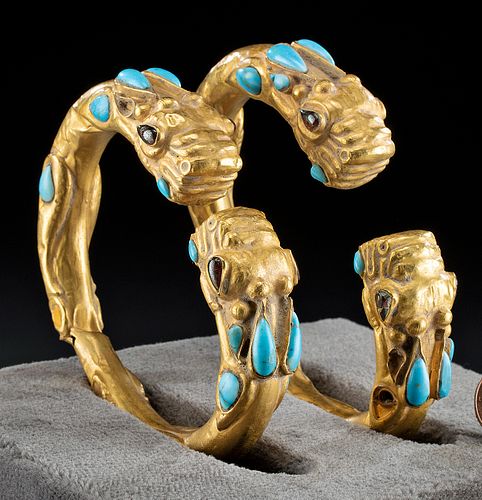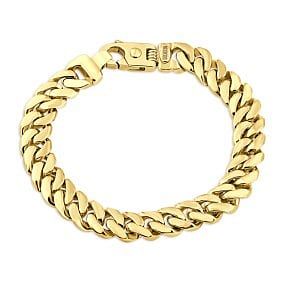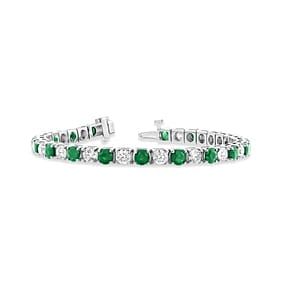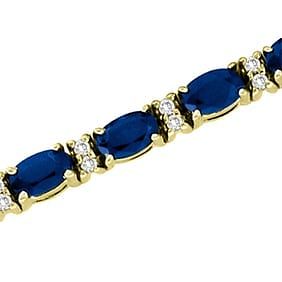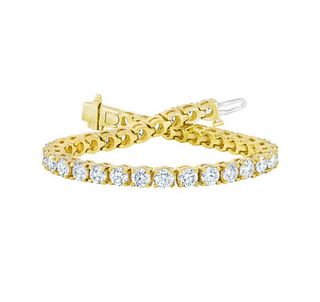Achaemenid Gold Bracelets w/ Turquoise, Garnets (pr)
Lot 64
About Seller
Artemis Fine Arts
686 S Taylor Ave, Ste 106
Louisville, CO 80027
United States
Selling antiquities, ancient and ethnographic art online since 1993, Artemis Gallery specializes in Classical Antiquities (Egyptian, Greek, Roman, Near Eastern), Asian, Pre-Columbian, African / Tribal / Oceanographic art. Our extensive inventory includes pottery, stone, metal, wood, glass and textil...Read more
Categories
Estimate:
$40,000 - $60,000
Absentee vs Live bid
Two ways to bid:
- Leave a max absentee bid and the platform will bid on your behalf up to your maximum bid during the live auction.
- Bid live during the auction and your bids will be submitted real-time to the auctioneer.
Bid Increments
| Price | Bid Increment |
|---|---|
| $0 | $25 |
| $300 | $50 |
| $1,000 | $100 |
| $2,000 | $250 |
| $5,000 | $500 |
| $10,000 | $1,000 |
| $20,000 | $2,500 |
| $50,000 | $5,000 |
| $100,000 | $10,000 |
| $200,000 | $20,000 |
About Auction
By Artemis Fine Arts
Oct 8, 2020
Set Reminder
2020-10-08 10:00:00
2020-10-08 10:00:00
America/New_York
Bidsquare
Bidsquare : Exceptional Antiquities, Asian, Ethnographic
https://www.bidsquare.com/auctions/artemis-gallery/exceptional-antiquities-asian-ethnographic-5796
Museum-worthy examples of Egyptian, Greek, Roman, Etruscan, Near Eastern, Far East / Asian, Pre-Columbian, African / Tribal,Oceanic, Native American, Spanish Colonial, Russian, Fossils, Ancient Jewelry, Fine Art, so much more! Artemis Fine Arts info@artemisfinearts.com
Museum-worthy examples of Egyptian, Greek, Roman, Etruscan, Near Eastern, Far East / Asian, Pre-Columbian, African / Tribal,Oceanic, Native American, Spanish Colonial, Russian, Fossils, Ancient Jewelry, Fine Art, so much more! Artemis Fine Arts info@artemisfinearts.com
- Lot Description
Ancient Near East, Achaemenid Persian Empire, ca. 550 to 330 BCE. Comprised of 93% gold (equivalent to 22K+) and lavishly decorated with turquoise and garnet cabochons, a magnificent pair of matching bracelets with zoomorphic head terminals reflecting a taste for luxury and opulence. The skill and artistry employed to render every inch of each bracelet's surfaces is astounding. The animal heads feature almond-shaped garnet eyes, teardrop-shaped bright blue turquoise ears, and an abundance of turquoise inlays to further embellish the forms. Furthermore, the intricate modeling of their snouts as well as the sinuous motifs - perhaps wings or plumes - adorning their bodies along the bangles is beyond impressive. Size of largest: 3.7" W x 2.625" H (9.4 cm x 6.7 cm); (interior): 2.9" W (7.4 cm); (largest turquoise): 0.75" L x 0.2" W (1.9 cm x 0.5 cm); quality of gold: 93% (equivalent to 22K+); total weight: 91.7 grams (smaller is 43.6 grams, and larger is 48.1 grams)
The Achaemenid love of gold and silver was famous throughout the ancient world. Plato wrote of how the acquisition of gold and silver was considered a virtue while Alcibiades, another Athenian, wrote of the enormous wealth in gold and silver that the Persians had. In a society where flaunting wealth was important, these bracelets would have been prized possessions, demonstrating the high social status of its wearer. In addition, the inclusion of lions, ibexes, swans, gazelles or mythical creatures such as griffins or horned lions in jewelry like this was customary. It is likely that these treasured bracelets eventually became grave goods, placed into a tomb alongside other cherished pieces to accompany the deceased into the afterworld.
The Achaemenid Persian Empire, founded by Cyrus the Great in 550 BCE (including Iran, Mesopotamia, Syria, Egypt, Asia Minor, Central Asia, Caucasus, Thrace and some parts of India) is generally regarded as one of the greatest civilizations of the ancient world. Its capital, Pasargadae, was Cyrus the Great's final resting place and has been named a UNESCO World Heritage Site.
These bracelets compare with examples in the Tillya Tepe (Hill of Gold) - a burial site for one man and five women of whom one was a princess - in Jowzjan province dating to the 1st century BCE. See "Bactrian Gold: From the Excavations of Tillya Tepe Necropolis in Northern Afghanistan" by Victor Sarianidi (1985), translated from Russian by Arthur Shkarovsky-Raffe Aurora Publishers, Leningrad, especially pp. 163-167.
Provenance: private California, USA Collection; ex-private collection of a doctor who traveled to Iran and Afghanistan to practice medicine, acquired in the late 1950s
All items legal to buy/sell under U.S. Statute covering cultural patrimony Code 2600, CHAPTER 14, and are guaranteed to be as described or your money back.
A Certificate of Authenticity will accompany all winning bids.
We ship worldwide and handle all shipping in-house for your convenience.
#155837Bracelets have a few chips and losses to some stones, minor abrasions, and light encrustations, with stable hairline fissure in the middle of the smaller bracelet, and minor softening to some finer details, otherwise intact and excellent. Wonderful patina and stones throughout.Condition
- Shipping Info
-
All shipping is handled in-house for your convenience. Your invoice from Artemis Gallery will include shipping calculation instructions. If in doubt, please inquire BEFORE bidding for estimated shipping costs for individual items.
-
- Buyer's Premium



 EUR
EUR CAD
CAD AUD
AUD GBP
GBP MXN
MXN HKD
HKD CNY
CNY MYR
MYR SEK
SEK SGD
SGD CHF
CHF THB
THB